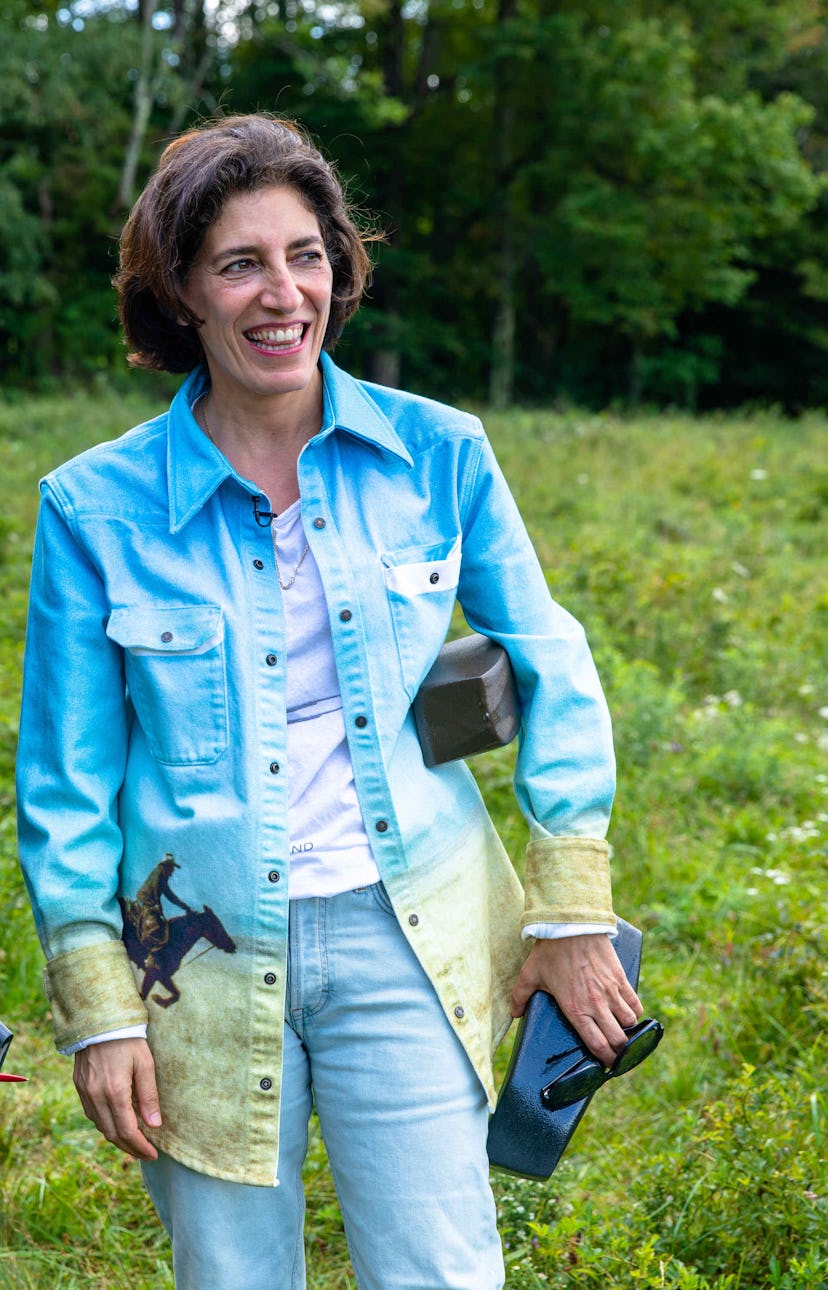Artist Nairy Baghramian Reflects on 2020, a Year of Essential Work
The sculptor's work, which speaks to labor and identity in the social space, took on new meaning amid the pandemic and the Black Lives Matter movement.

The artist Nairy Baghramian was standing on the green, loping hills of The Clark Art Institute in Western Massachusetts when she found out that Joe Biden had won the election. Baghramian’s sculpture “Knee and Elbow,” which was installed at The Clark’s Stone Hill meadow in August, wasn’t far from where she and some friends received the news; she could see the massive joints, rendered in white and pale pink marble and steel, while she jumped up and down on the grass, screaming with joy.
For Baghramian, who was born in Isfahan, Iran in 1971 and moved to Germany at 14 (she’s been based in Berlin ever since), being in the U.S. at that moment felt particularly momentous. She felt a huge sense of relief. Like many, the 49-year-old sculptor had spent the days prior to November 7 glued to cable news, “a junkie in front of the TV for three nights, only interrupted by long walks in empty Central Park,” she says.
“I didn’t sleep a second,” she adds during our Zoom call in late November. “I was calling some of my friends in Germany and they said, ‘Nairy, it’s midnight. It’s four o’clock in the morning.’ The numbers got stuck in my head and even two days later, the anchor man from CNN popped up in my dreams.”
Baghramian’s preoccupation with the election and American politics makes sense, as these topics inform and shape her award-winning artwork. In 2019 she received Performa’s Malcolm Mclaren and the Guggenheim’s Hugo Boss Prize, for which she was nominated again this year. Her works speak to issues of labor, employment, and identity in the social space—all of which have come under heightened scrutiny in 2020. And indeed, “Knee and Elbow,” a piece intended to highlight the vulnerability of the human form and suggest, in the artist’s words, a “possible collapse,” feels especially resonant today. But when Baghramian was making the sculpture this year, she wasn’t necessarily thinking of 2020’s tumult. In fact, she says she hadn’t considered “Knee and Elbow” through the 2020 lens until our conversation.
“With my work, I don’t really comment on the politics of the day. But of course we are all related and influenced by the present,” she says. “And ‘Knee and Elbow’ is certainly about how we coexist next to each other—who is taking the burden, who is doing the work.”
She links “Knee and Elbow” to her previous work, referencing a two-part piece she made in 2009 called “Construction Helper” for an exhibition in Austria and her 2018’s “Maintainers” for the MoMA: “These works could be exemplary for some discussion around inseparable sculptural and social issues such as instability, hierarchies, dependencies, privileged positions and production processes. The whole idea of other people doing work for you who are invisible, or who polish the work, and then they disappear.”
I mention that this notion can be connected to arguments pertaining to the Black Lives Matter movement, namely that Black people built the United States both literally and figuratively but then were cast aside, and she agrees.
“This is a moment when we should face the problem and certainly not hide it. We should confront ourselves with our perpetual ignorance,” Baghramian says. “We must open up the problem, look inside of it. More or less, each of us has a part in it.”
Baghramian sees the pandemic as another “problem that you don’t like to face,” especially as it pertains to working people of the world. During the course of 2020, she’s seen the concept of “social distancing” become a class issue, as essential workers do not have the choice to properly distance themselves from others. She finds the phrase itself harsh, leading to a loss in the interconnectedness of the world.
“People who have to go to work daily—at grocery stores, or running the Metro, or the buses—they are not able to say, ‘I would like to stay home, and look at my garden.’ To do that, you have to have access to that world. When I look at the art world—how many people have been able to leave the city to be in their gardens? A teacher or a woman with three kids in a little apartment in New York, cannot do that. I thought, let’s still be careful and caring about each other. Closeness doesn’t mean always being physically close.”
According to the artist—who is currently at work on her next piece, which will also be done in marble, “Misfits,”—many of those late-night, anxiety-fueled calls during the election were made to friends in Europe. Baghramian found that those European contacts overwhelmingly believed Donald Trump would secure a second term. Meanwhile, her American friends remained hopeful that Biden would win.
“Maybe I’m too naive, but I believe in the U.S. as a country,” she says. “It’s the people who create this discussion. They give these problems space, while other countries stifle the problems. I believe that this country is still a democratic place to live in. Otherwise, we would not be able to negotiate all these problems.”
“The U.S. has proven that there is a change possible,” Baghramian adds. “Let’s hope this country has the potential to make more change, which is necessary.”
Related: After Months of Online Viewing Rooms, Outdoor Art Exhibitions Fill the Void